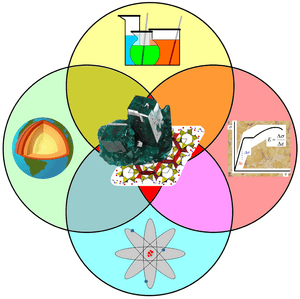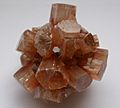Mineralogy facts for kids
Mineralogy is the study of minerals. Minerals are the natural materials that make up rocks. There are many different kinds of minerals. Some are very hard, like diamonds. Others are very soft, like talc. Some minerals are metals, such as gold or silver. Minerals are put into special groups. These groups are based on what chemicals they are made of or how their tiny parts are arranged inside. For example, the chemicals in some minerals form long chains, while in others, they make shapes like bow-ties.
Studying minerals helps us understand rocks better. The shape or size of minerals can tell us important things about a rock. For instance, in igneous rocks (rocks formed from cooled lava), the size of the minerals can show how fast the rock cooled down. Large minerals mean the rock cooled slowly, probably deep underground. Small minerals mean it cooled quickly, like from a volcano on the surface. The type of mineral also helps identify a rock or understand what has happened to it since it formed. Many rocks are even named after the minerals they contain.
How Mineralogists Study Minerals
Mineralogists are scientists who study minerals. They use special tools to look closely at minerals in rocks.
- They use hand lenses, which are like magnifying glasses, to see details.
- They also make very thin slices of rock, called thin sections. They look at these thin sections using microscopes.
When studying minerals, mineralogists record many things. They note how big the minerals are and what shape they have. They also write down their color and if the color changes when you turn the mineral. Mineralogists even check what color minerals appear under a special light. All these details help them figure out exactly which minerals they are looking at.
Uses of Minerals
Minerals are used in many different ways in our daily lives.
- They are used to make beautiful jewelry.
- Minerals are important in farming to help plants grow.
- They are used in making pottery and ceramics.
- Minerals are also essential for getting metals like iron and copper.
Mineralogists play a key role in finding important minerals hidden in the Earth. Their knowledge helps us discover and use these valuable natural resources.
Images for kids
-
Page from Treatise on mineralogy by Friedrich Mohs (1825)
-
The Moon Mineralogy Mapper, a spectrometer that mapped the lunar surface
-
Calcite is a carbonate mineral (CaCO3) with a rhombohedral crystal structure.
-
Photomicrograph of olivine adcumulate from the Archaean komatiite of Agnew, Western Australia.
See also
 In Spanish: Mineralogía para niños
In Spanish: Mineralogía para niños












